Top 15 Interesting Places to Visit in Croatia
Croatia is one of the most beautiful countries in Europe, in no small art
thanks to its proximity to the Adriatic Sea and a very diverse climate and
terrain. Like other parts of the Balkans, it has an incredibly rich history,
beginning with the arrival of the Croats in the present-day territory of Croatia
during the great migrations of the 7th century. Apart from the numerous beaches
and scenic lookouts, the countryside of Croatia covers a wide range of terrain.
This is seen throughout Croatia's cliffs,
mountain ranges, and infamous Adriatic highlands. Croatia's historical legacy
and dynamic terrain makes
visiting this dynamic country so memorable and attractive.
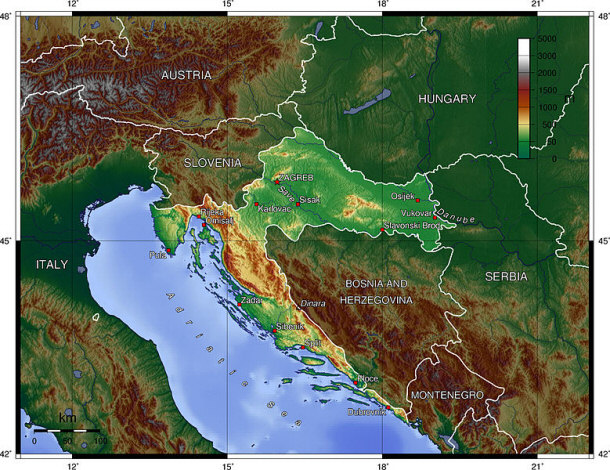
By Captain Blood,
from Wikimedia Commons
Here are the top fifteen places to
visit while staying in Croatia.
15) Krka National Park
Named after the river that encloses it, this national park is one of several
in Croatia. What makes it notable is its beauty and sheer variety of wildlife
and plant life in the region. Although located in the southern European region
climate-wise, the park has a mosaic distribution of different types of habitats,
making it an especially rich nature preserve. In raw numbers, there are over 860
different species and subspecies of plants in the park alone. This includes a number
of plants that are unique to Krka, and are not found anywhere else in the world.
The river is inhabited by some 18 species of fish with 10 species that are endemic to
the river, making it one of the most notable parks in the country.
Skradinski Buk Waterfall on the Krka River
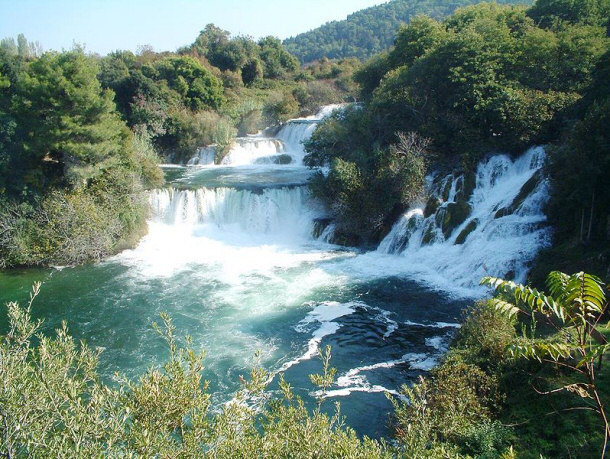
Of course, that's not all Krka has to offer for visitors. There are over two hundred different species
of birds, including ospreys, short-toed eagles, peregrine falcons, Eurasian
eagle-owls, the Griffon vulture and many more indigenous species of birds. If you aren't an ornithologist, but
prefer bats, Krka also has some eighteen species of bats, most of which are
classified as endangered or near extinction. Visiting Krka is well worth it,
especially since the area has a very well developed tourist infrastructure,
allowing you to go on sightseeing tours without having to worry about ruining
the delicate ecosystem. For history buffs, the park is also host
to the remains of a number of Roman fortresses that date back to the third century when Croatia was one of Rome's colonies on the Adriatic coast.
14) Salona
If you are interested in learning more about the rich history of the region,
especially during Roman times, you need to head over to Solin, which is part
of the Split conurbation. The town is famous for its plentiful archeological
sites coming from the settlement of Salona, which was one of the most important
cities of the ancient Roman province of Dalmatia. Salona was important both
politically and religiously, though its prominence waned with the building of
Diocletian's Palace just a few kilometers down the coast. The city never
regained its standing and was eventually destroyed by invading Slavs somewhere
around the
seventh century.
Ancient Roman Ruins in Salona
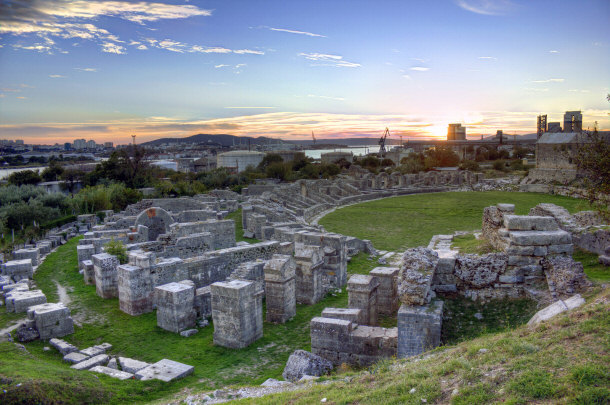
However, the destruction wasn't complete and ruins of the Roman settlement
survive to this day. Counting 60,000 inhabitants at the height of its influence
and power, the city was home to plenty of industries that provided it with
plenty of
goods for trading. Public baths (the thermes), extensive fortifications, gates,
and a forum that served as the nexus of the city's political, religious,
and financial life. Ruins of all of these buildings can be seen today because
they were well preserved by archaeological and restoration efforts over the
years.
Ruins of Salona Near Split, Croatia
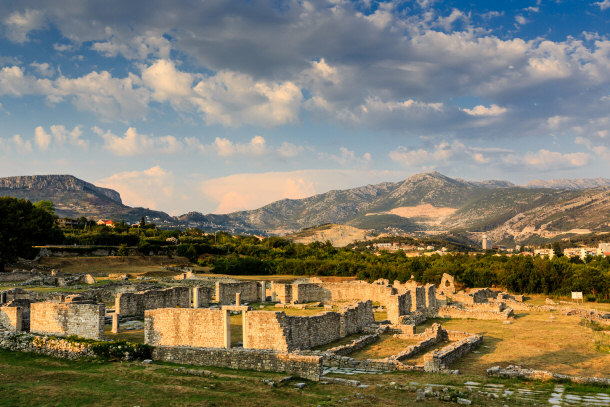
If you hold even a passing interest in
the history of Rome, visiting Salona is an essential addition to your list of
places to visit since it demonstrates not only how Emperors lived, but also the
common people that made up the majority of the Roman Empire.
13) Pula
Of course, the Roman history of Croatia is not the only worthwhile element of
Croatia's history. A good way to see the entire history of the country in a nutshell
is to visit the city of Pula.
Roman Amphitheater in Pula, Croatia
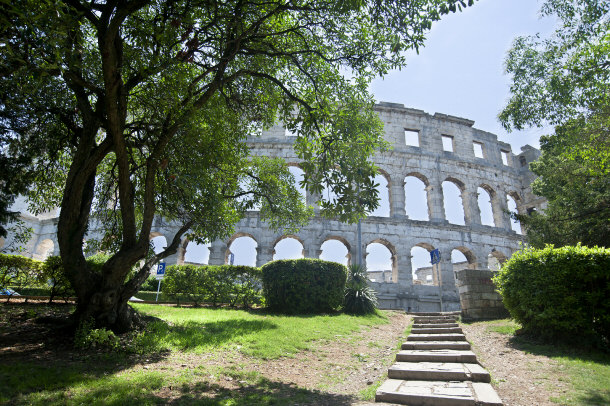
One of the most important cities in the province
of Dalmatia, it had a particularly well developed infrastructure, including a
massive amphitheater that is one of the six largest Roman structures of this
type still left standing. The fall of the Roman Empire brought radical change to
the city brought on by the sacking of Pula by the Ostrogoths. The city was subsequently controlled by
dozens of different entities, from the Frankish Kingdom of Charlemagne, through
the trade republic of Venice, to the Austrian Empire and beyond. Its rich
political history has endowed the city with a unique blend of cultures and
traditions that survives to this day.
In terms of physical examples of history, Pula is well known for its numerous
ancient Roman buildings including the amphitheater that is pictured above. Other
notable landmarks
include numerous arches and gates leading into the city that formed part of the
fortification line, as well as the Augustan Forum. Later stages in the city's
history are marked architecturally by churches, especially the Byzantine chapel of St. Mary
Formosa and the Church of St. Francis.
Byzantine Chapel of St. Mary Formosa
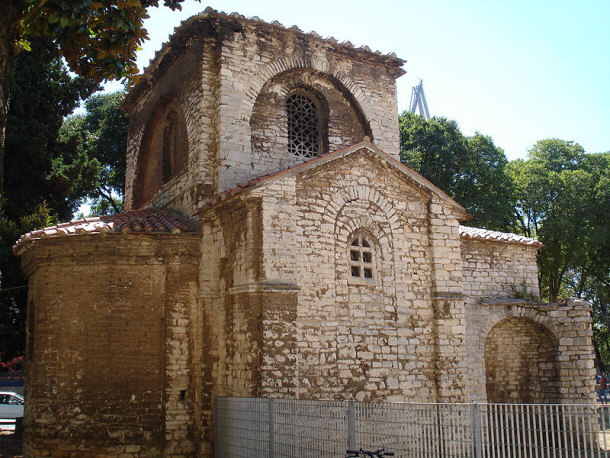
Lerner.hu at the English language Wikipedia [CC-BY-SA-3.0, GFDL or CC-BY-SA-3.0],
from Wikimedia Commons
For aficionados of military history, the
city also has plenty of fortifications from the time Austria controlled the
city. In short, it's the perfect city to visit if you want to catch a glimpse
into Croatia's intriguing, tumultuous history.
12) Velebit Mountain Range
Sometimes, history is not enough to keep everybody entertained while on
vacation. Taking in some of the natural
beauty Croatia has to offer can please travelers who have had their fill of
history lessons, and are looking for more adventure than historical sites can
offer. The Velebit mountain range and the National Park that covers a sizable part of its
northern elements is a great choice for more adventurous vacationers. Often neglected by tourists in favor of more well-known areas
and nature preserves such as the aforementioned Krka National Park, it is
nonetheless one of the most striking places to visit in Croatia. This mountain range
is brutal, beautiful, and breathtaking.
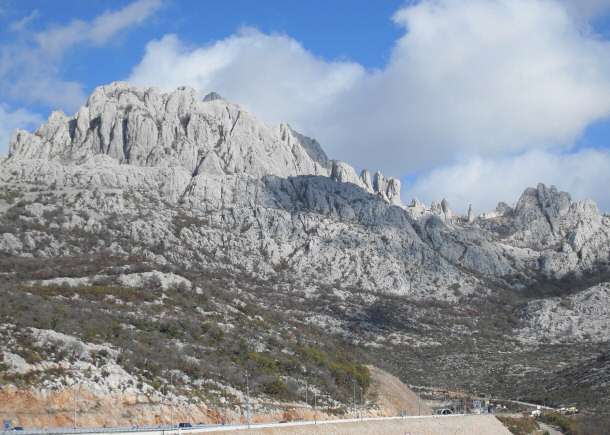
By
Ekem,
from Wikimedia Commons
The Velebit is predominantly made up of simple rock formations which form
sheer cliffs and exposed, naked surfaces bathing in the Mediterranean sun. The
sea-facing slopes of the mountain range are usually almost naked, save for
grass, shrubbery, and plenty of rocks. The slopes facing inland are, by
contrast, often covered in dense forests. Together, these come to form one of
the most memorable regions in Croatia, especially when you consider the variety
of flora and fauna present on Velebit. If you're limited by time, consider, at
least, visiting National Park Sjeverni Velebit (Northern Velebit), which offers
the most beautiful sights and experiences in the Velebit range by far.
11) Rovinj
Often described as one of the most picturesque cities in Croatia, Rovinj has
an equally storied history, starting as a settlement of Illyrian tribes, then a
Roman town, a Byzantine city, a Frankish frontier town, and finally, at the apex
of its power and influence, the most important city in Istria aligned with the
Republic of Venice. For over five centuries, Rovinj benefited from its
relationship with the mighty trade republic, until Venice's fall, at which point
it was absorbed by the Austrian Empire. Subsequent history is common to all
Croatia after World War I.
The Pier and the City of Rovinj on Istria Peninsula
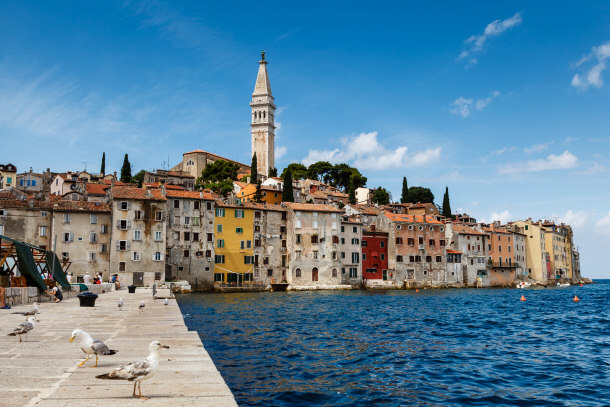
The long and varied history of Rovinj is reflected in its architecture, from
the Monkodonja hill forts dating back to 1800 BCE to the modern day fishing
ports. The city is known for its beauty, unmarred by years of urbanization and
industrialization that have shaped most of Croatia. This is primarily due to the entire Rovinj archipelago, which
consists of a total of 19 islands lush with vegetation that are set against the
backdrop of the Croatian mainland. The historic architecture of the city is just
an added bonus for visitors who have the chance to explore this picturesque
city.
10) Hum
Fascinating oddities aren't just nature's domain in Croatia. Humans have
plenty of their own, and one of the most interesting is the little town of Hum,
located in central Istria. What makes it notable is the fact that it's the
holder of the Guinness World Record for the smallest town in the world. The 2001
census placed the official number of inhabitants at just 17 people. Although one
would expect it to be little more than just a few huts arranged around a road,
but the town is actually known for its incredibly well preserved medieval urban
architecture and layout.
Bell Tower in Hum
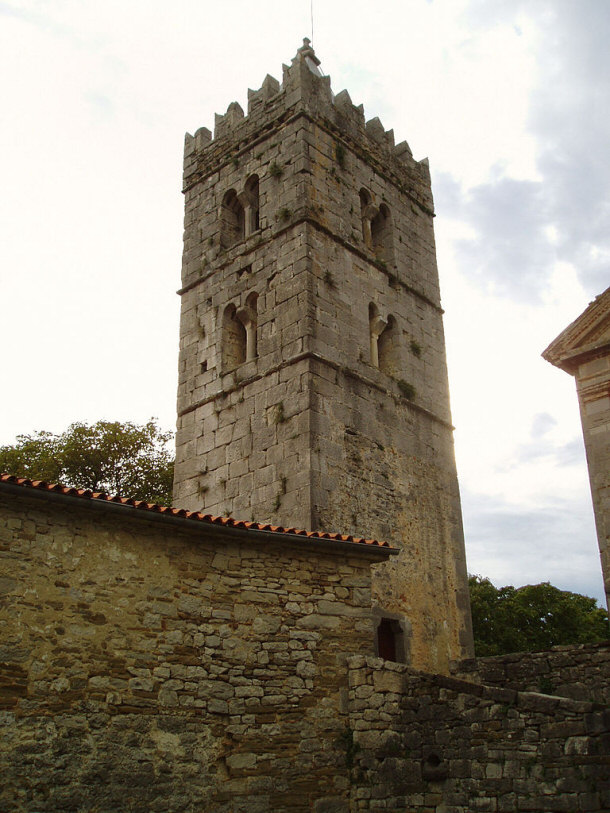
The city's defining feature is the defensive wall enclosing it. In fact, most
of the houses in the town are actually built into the defensive walls. The
history of the town first begins around the 12th century, where it is mentioned
in several documents. The Parish Church of St. Jerome
is notable for the preserved early Glagolitic writings held inside, which are
one of the oldest existing artifacts of Croatian literature of the Middle Ages.
Coupled with the scenic landscape surrounding the smallest little city in the
world, Hum is worth visiting, especially if you enjoy medieval towns and
architecture.
9) Trogir
The rich history of Croatia is embodied by its many historical towns. Trogir
is one of UNESCO''s World Heritage Sites, a town with over two thousand years of
history of settlement and habitation. Originally founded in the third century BCE, Trogir
was founded by Greek colonists, developing into a major port during the Roman Empire. The rise of the aforementioned Salona resulted in Trogir
losing prominence. When Salona was sacked by
migrating Slavs, Trogir harbored refugees from the once great city.
Aerial View of Trogir, Croatia
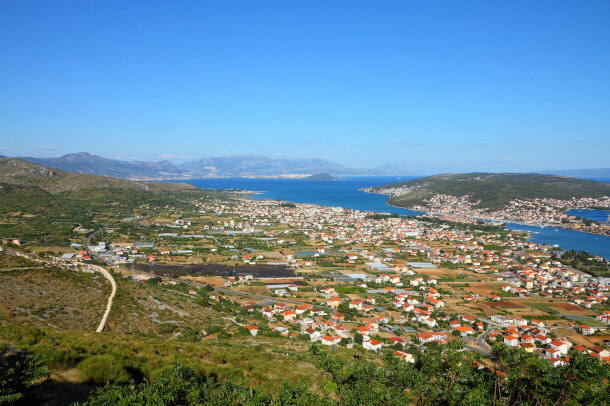
Nothing lasts, and Trogir was sacked by the Saracens in the 12th century, but
recovered fast and became one of the most important economic centers of Croatia.
In subsequent centuries it enjoyed a history similar to Pula, with its fortunes
waning and waxing, as empires rose and fell in the region.
Historic District of Trogir
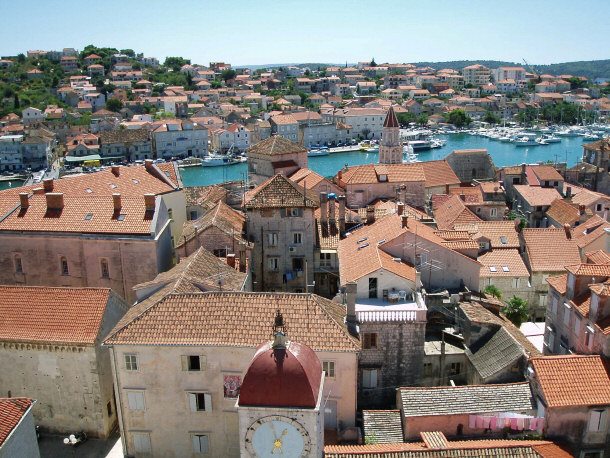
The rich history of Trogir makes it a mandatory stop on any voyage aiming to
provide more than just the bare minimum of Croatian history. Trogir is an
exceptional place, as it's commonly regarded to be one of the finest complexes
of Romanesque, Gothic, Renaissance, and Baroque buildings in Europe. In fact,
this is one of the reasons it has been classified as a World Heritage Site. The
intricate mosaic of urban Trogir is one of the most fascinating sights in
all of Croatia.
8) Klis Fortress
Equally fascinating is the massive fortress of Klis in central Dalmatia. Like
many of Croatia's towns, it has a very rich history, which started with the
establishing of a small stronghold by the ancient tribe of Dalmatae. Since then,
it has been continuously expanded and upgraded for more than two thousand years,
eventually becoming a residence for the kings of Croatia, and one of the most
crucial fortifications in the wars with the Ottoman Empire. Sitting on the
crossroads between the Balkans and the Mediterranean belt, it was a point of
great strategic importance throughout history.
Klis Fortress
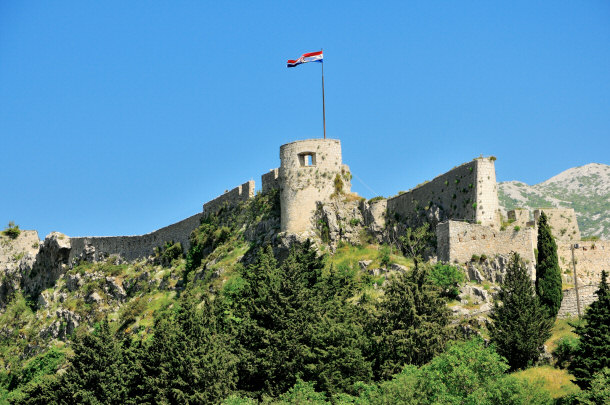
It is easy to see centuries of history embedded in its solemn stone walls.
The entire fortress is situated on the top of a large cliff, shaped like an
elongated spearhead. The stone faces of the mountain have been adapted and
integrated into the defensive architecture of the Klis fortress, which remains
one of the most remarkable examples of fortifications in this region of the
Adriatic Sea. Visiting it is a good idea for additional reasons beyond the
impressive structure. The fortress is
also host to a sizable collection of arms, armor, and uniforms, making it a
mandatory stop in the itinerary of any aficionado of military history.
7) Korcula
For a traveler that's pining to experience the unique culture and atmosphere
of Adriatic islands, the island of Korcula is one of the best places to visit.
It sums up all of Croatia in a nutshell, including everything the country has to
offer. This includes sunny beaches, crystal clear water, and towns with more
than a thousand years
of history and tradition. Korcula is rapidly developing and has something to
offer for practically everyone. Enjoy swimming? Head to the nearest beach.
Prefer hiking? The size of the island and its geography allow for lengthy trips
into the forest in order to climb the local peaks. Prefer exploring historical towns?
There's Korcula.
Korcula Island
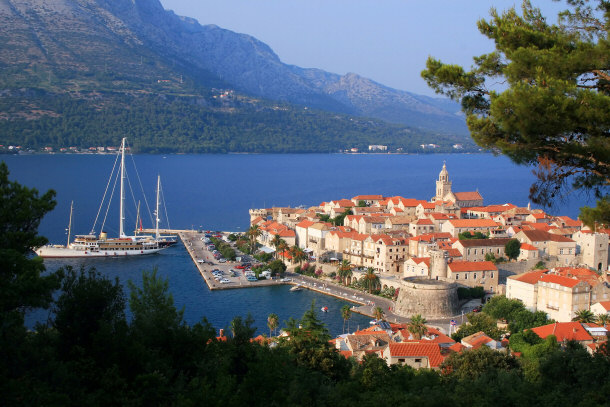
The most interesting town on the island is its namesake. Korcula is a
fortified town built in a unique Adriatic style, originally built to protect against violent
winds often present in the region. It offers plenty of winding streets to get
lost in, exploring the fascinating architecture of a city built on the edges of
two cultures. The most interesting buildings in the town include the Cathedral
of St Mark built over the course of five centuries, as well as the numerous
palaces of the local merchant nobles.
Church and Marco Polo Tower - Korcula Town
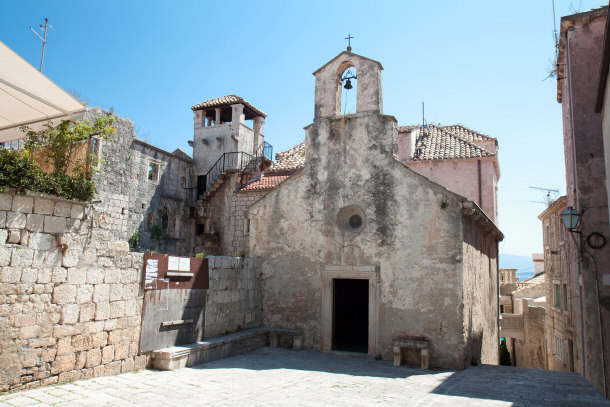
Of course, the sizable fortifications of Korcula are also a major attraction. An interesting fact related to the history
of Korcula is that it's the first place in the world where slavery was banned,
as a result of the 1214 Korcula town statute.
6) Zadar
Even in a country as rich in history and sights as Croatia, there are places
to visit that are especially important for numerous reasons. Zadar is one of
those, tracing its lineage back to Roman times and the development of the city
in the first century CE. The city was one of the most important urban centers in
the province of Dalmatia and a vital element of the Roman economy there.
Although it stagnated after the fall of the Empire, it regained its prominence
by the beginning of the Middle Ages. Its advantageous position brought it into
political conflict with its neighbors, most notably the Republic of Venice,
which was an integral element of the city's history until the republic's fall,
at which point Zadar was absorbed by the Austrian Empire.
City Of Zadar Harbor And Velebit Mountain
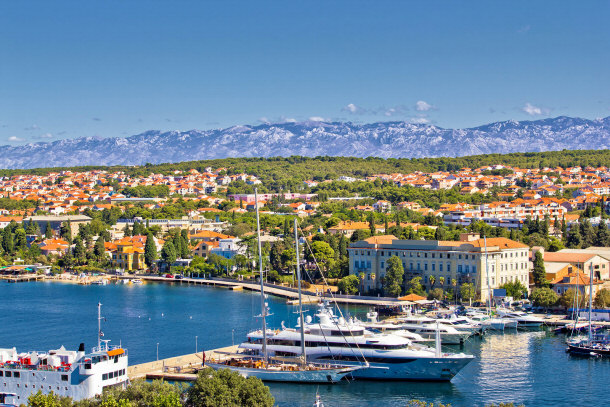
Fishing Boats in the Port of Zadar

The long, rich history of the city shows in the architecture. Unlike many
other cities, Zadar has retained its Roman layout, with the most interesting
feature dating back to the Roman times being, of course, the forum. However, the
true beauty of Zadar lies in its churches, which span nearly all architectural
styles, from Romanesque to Baroque. Walking through the streets of the three
thousand year old Zadar is akin to using a kaleidoscope: a different sight with
every turn you take.
5) Zagreb
The capital of Croatia is the largest city in the entire country and one of the
most varied. Its history dates back to the 11th century, making it one of the
younger cities in Croatia. However, make no mistake; its history is just as
intriguing as the rest of Croatia. Among other sites (including the seat of the Croatian parliament
and government), perhaps the most fascinating part of the city lies in the Gornji Grad (Upper Town) district, which is the medieval old town. It is
currently one of the most well preserved medieval urban centers in Europe.
Panorama of Zagreb
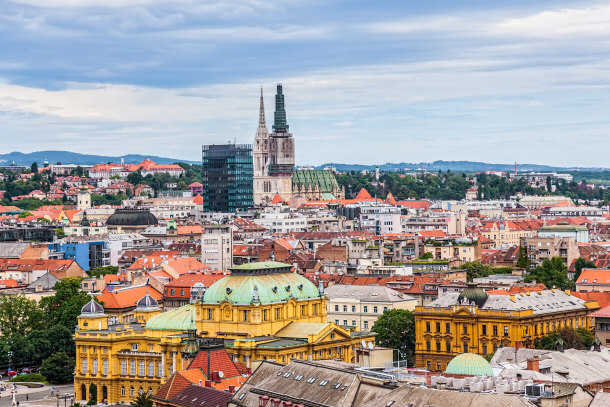
However, the real treat in Zagreb is its numerous museums that are continuing
to devote themselves to the history, art, and culture of Croatia. With over
thirty collections spread over the museums in Zagreb, there are more than 3.5
million exhibits to see. The most fascinating of those is perhaps the
Archeological Museum, containing 450,000 exhibits including an extensive
Egyptian and Numismatic collection. Second is the Croatian Natural History
Museum, with over 250,000 exhibits. Art connoisseurs will definitely appreciate
the numerous galleries, with the Modern Gallery and the Museum of Modern Art
being the most recommended starting point for visitors. Zagreb has something for
everyone, especially visitors who are highly inclined to visit art museums.
4) Porec
Located on the Istrian peninsula, Porec is a two thousand year old city whose
settlement dates back to the second century BCE, though it didn't become a city
until the rule of Emperor Octavian August in the first century CE. As a Roman
city from the beginning, Porec's history is tied to the fortunes of the Empire
and successor states that emerged in the wake of its fall. Porec was a part of
the Roman Empire, then the Byzantine Empire, and then became a part of the merchant
empire of Venice. Shortly after, Porec was absorbed as part of the Habsburg
Dynasty's rule and then became part of the Austrian Empire. The town has a long
and storied history, but perhaps the most notable landmark is the Euphrasian Basilica.
Roofs of Porec on a Sunny Day
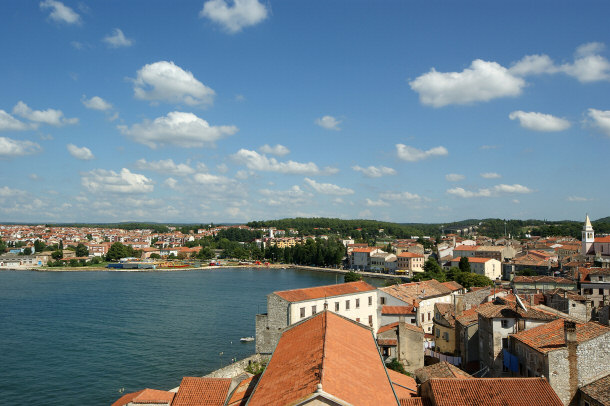
The Basilica is an UNESCO World Heritage Site, and for good reason. It is one
of the best preserved examples of early Byzantine architecture, with its main
structure dating back all the way to the sixth century. As the third church
built on the same location, it combines all the finest elements of early
Byzantine architecture. The most striking element of the Basilica is the
intricate mosaics covering its walls and floor. It's exceptional architectural
and artistic value resulted in it being granted the title of a World Heritage
Site.
Clock Tower in Old Town Porec - Istria Peninsula
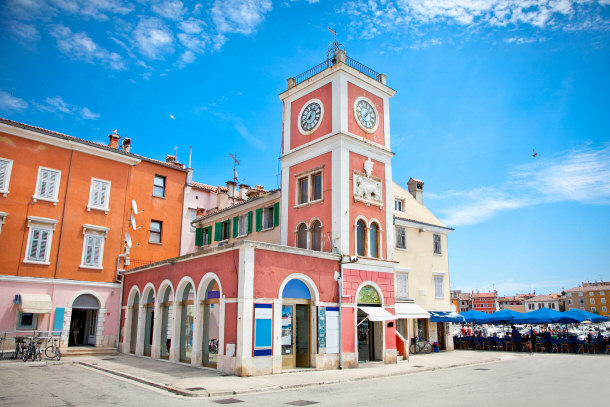
When you visit it in person, you will definitely understand why it was
designated as a World Heritage Site.
3) Diocletian's Palace in Split
Built between the third and fourth century CE, Diocletian's Palace is one of
the most important UNESCO heritage sites in Europe. The reason for this is
simple: it's the most complete and most well preserved Roman palace on the
continent. This fact earned it global fame and recognition and made it a very
common tourist destination in Split, a city that effectively sprung up around
the palace. The palace itself was built by the Emperor to prepare for his
retirement in 305 CE and was one of the largest complexes of its time. It was
capable of housing over nine thousand people at its peak. It should also be
noted that the palace was also fortified on all sides, except for the southern
facade that utilized the
sea as a natural barrier.
Diocletian's Palace in Split
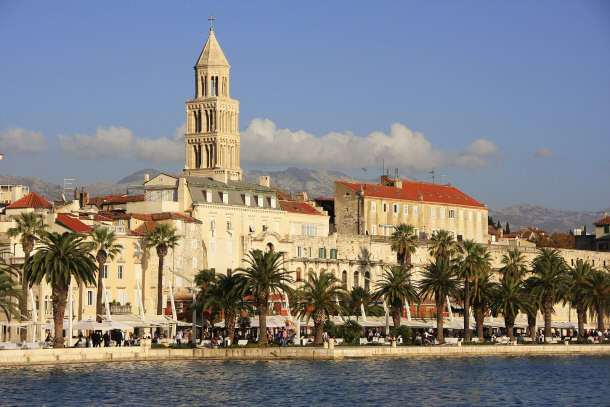
The remarkable preservation of the entire site means that it's an incredibly
rich and inspiring place to visit. The Roman architecture of the time is still
sure to
impress, especially when you consider that it was made with a less advanced
technology during
medieval times.
Inside the Walls of Diocletian's Palace
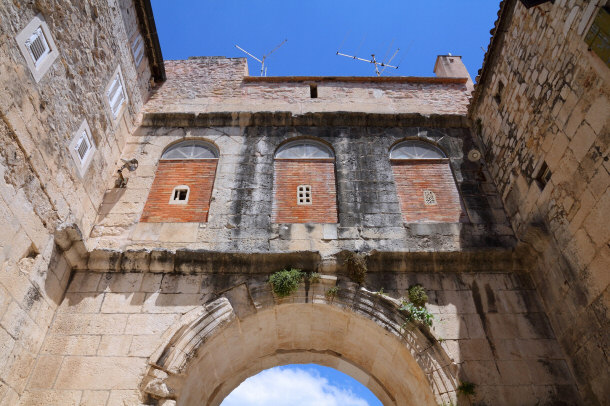
Perhaps the most worthwhile sight in the palace is the 3,500
year old sphinx statue, made from granite. Although originally there were dozens
of such statues on the grounds only two survive, with a third one
located in Split's city museum.
2) Plitvice Lakes National Park
The oldest national park in south-eastern Europe, Plitvice Lakes was
founded in 1949 to protect the unique geography of the region, which resulted
in a world-famous cascaded arrangement of lakes. The entire park covers nearly
300 square kilometers and encloses sixteen interconnected lakes, forming a
beautiful network that quite literally has to be seen to be believed. Plitvice
Lakes is also one of the most popular tourist destinations in Croatia, with an
estimated 1,200,000 visitors each year. As strict rules apply to all visitors,
it's worth preparing for the trip in advance and making sure that you comply
with all the regulations enforced by the national park authority.
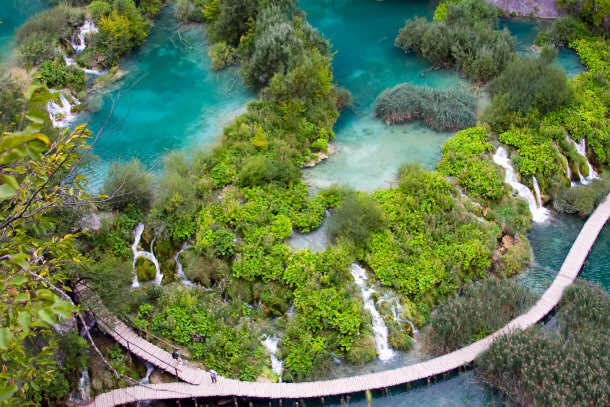
However, working your way through the labyrinth of regulations is worth it,
as the arrangement of lakes and the intricate ecosystem that formed
are globally unique. The lakes are divided into two distinct clusters, separated
by a descent nearly 150 meters in height.
Picturesque Waterfalls Inside Plitvice Lakes National Park
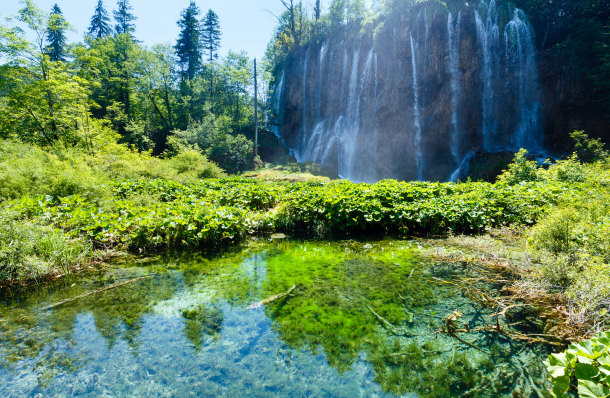
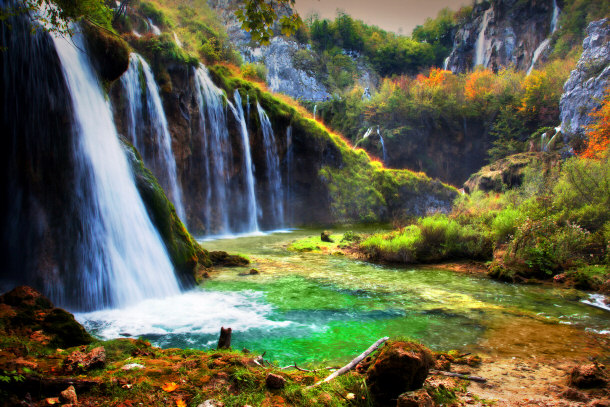
Although spectacular on its own, the real kicker comes when you realize how
colorful the lakes are. Finally, the national park is home to plenty of wild
animals, many of them endemic to the area and cannot be seen anywhere else.
1) Dubrovnik
At the top of the list of must-see places in Croatia is Dubrovnik. Commonly
referred to as the Pearl of the Adriatic, the old city of Dubrovnik is a UNESCO
World Heritage Site. This is due mostly to its architecture, beauty, and
historical significance.
Ancient Fortified City of Dubrovnik
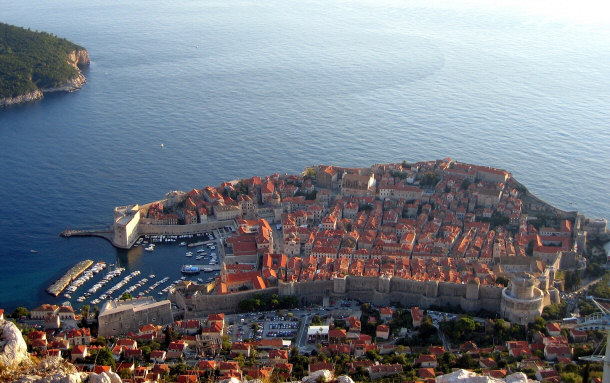
Dubrovnik was one of the most important cities in the Mediterranean Sea, and
serves as the capital of the maritime Republic of Ragusa.
Panoramic View of the Beautiful Beach in Dubrovnik
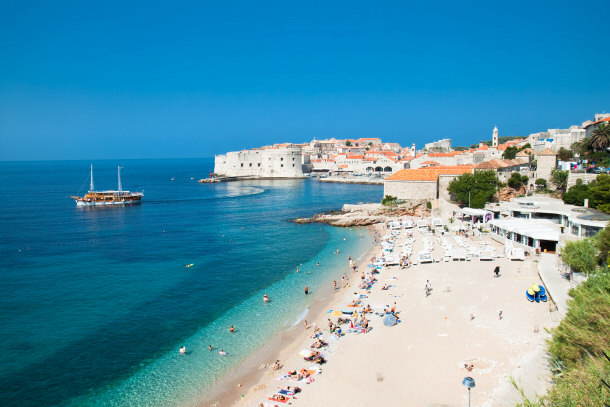
Its
prominence and wealth brought in through trade and diplomacy made it one of the
most influential cities in the region. In fact, at the apex of its power, Ragusa
could compete with even the mighty Venetian Empire.
Final Thoughts
Croatia is one of the most popular vacation destinations in Europe, not
without a good reason. It is a fascinating region brimming with history and
natural beauty. These fifteen sites and sights are all worth visiting, but they
only scratch the surface of what's to find in the Republic of Croatia.
Vacation Destinations
Top Lists:
Top 15 Interesting Places to Visit in the Bahamas
Top 15 Fun Things to Do in Miami, Florida
Top 15 Fun Things to Do in Chicago
Top 15 Best Unknown Things to do in Las Vegas
Top 15 Fun Things to Do in Hollywood
Top 10 Best Places to Visit in Turkey
The Top 15 Best Things to Do and See in Sydney
Top 10 Things to Do in Edinburgh
Top 10 Things to do on Oʻahu
Top 15 Things to Do in Albuquerque
Top 15 Interesting Places to Visit in Spain
Top 15 Places to Visit in New York City
Top 15 Things to Do in Portland Oregon
Top 15 Things to do in Greece
Top 15 Places to Visit in Houston Texas
Top 15 Interesting & Safe Places to Visit in Mexico
Top 15 Interesting Places to Visit in the Netherlands
Top 15 Interesting Places to Visit in Thailand
Top 15 Interesting Places to Visit in Switzerland
Top 15 Interesting Places to Visit in Portugal
Top 15 Places to Visit in San Francisco
Top 15 Interesting Places to Visit in Shanghai
Top 15 Interesting Places to Visit in Puerto Rico
Top 15 Interesting Places to Visit in Norway
Top 15 Interesting Places to Visit in Las Vegas
Top 15 Interesting Places to Visit in Jamaica
Top 15 Interesting Places to Visit in Croatia
Top 15 Interesting Places to Visit in Belgium
Top 15 Interesting Places to Visit in Bangkok
Top 15 Things to Do in Rio de Janeiro
Top 15 Things to Do in Monaco
Top 15 Interesting Places to Visit in Dubai
Top 15 Interesting Places to Visit in Amsterdam
Top 15 Things to Do in New Zealand
Top 15 Interesting Places to Visit in Paris
Top 15 Interesting Places to Visit in Italy
Top 15 Interesting Places to Visit in Singapore
Top 15 Most Interesting Places to Visit in Berlin
Top 15 Best London Attractions
15 Little Known Facts About New York City Disney World Articles
Top 15 Disney World Rides for Adults
Top 15 Disney World Rides for Kids
Top 15 Disney World Resorts for Adults
Top 15 Disney World Resorts for Kids
15 Fascinating Facts About Disney World
Top 15 Fun Things to Do at Disney World’s Animal Kingdom
Top 15 Fun Things to Do at Disney's Hollywood Studios
Top 15 Fun Things to Do at Disney World's Epcot
Top 15 Fun Things to Do at Disney World’s Magic Kingdom
Shorter Top Lists:
Top 10 Tourist Attractions in San Diego
Top 10 Tourist Attractions In India
Top 10 Things to Do In Kansas City
5 Places You Should not Miss in Brazil
Top 5 Things to do in New York City
Informational:
Best Tourist Attractions In Vietnam
Taking in the Sights in Shanghai
Top Tourist Attractions in Perth, Australia
Nice places to visit while in Great Britain
Sampling the Foods at the Night Markets in Taipei
What to do for a Kenya Vacation
Best Attractions in Victoria, B.C.
Photos of the Luxor Hotel in Las Vegas
|